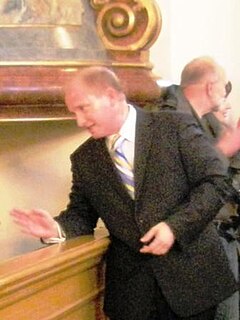Related Research Articles

Walter Hamor Piston Jr,, was an American composer of classical music, music theorist, and professor of music at Harvard University.
The Symphony No. 2, by Walter Piston is a symphony composed in 1943.
The Symphony No. 4 by Walter Piston is a symphony dating from 1950.
The Symphony No. 6 by Walter Piston was completed in 1955.
The Symphony No. 5 by Walter Piston was composed in 1954.
The Symphony No. 7 by Walter Piston is a symphony dating from 1960.
The Symphony No. 8 by Walter Piston is a symphony dating from 1965.
The Symphony No. 3 by Walter Piston was composed in 1946–47.
Walter Piston's Capriccio for Harp and String Orchestra, was commissioned in 1963 by Broadcast Music Incorporated on the occasion of its twentieth anniversary, and is dedicated to the harpist Nicanor Zabaleta, who premiered it in Madrid on October 19, 1964.
Walter Piston's Serenata for Orchestra is an orchestral suite or miniature symphony written in 1956.
The Sonatina for Violin and Harpsichord is a three-movement, neoclassical chamber work composed by Walter Piston in 1945, that marks the beginning of his postwar style.
Walter Piston's Fantasia for Violin and Orchestra was commissioned in 1970 by Mario di Bonaventura, music director of the Hopkins Center Congregation of the Arts at Dartmouth College, who conducted the world premiere on March 11, 1973, performed by the Dartmouth Symphony Orchestra with Salvatore Accardo as the soloist. The commission had been made specifically for Accardo.
String Quartet No. 1 by Walter Piston is a chamber-music work composed in 1933.
String Quartet No. 2 by Walter Piston is a chamber-music work composed in 1935.
String Quartet No. 3 by Walter Piston is a chamber-music work composed in 1947.
String Quartet No. 4 by Walter Piston is a chamber-music work composed in 1951.
String Quartet No. 5 by Walter Piston is a chamber-music work composed in 1962.

Theodore Kuchar is a Ukrainian American conductor of classical music and a violist.
Aaron Copland wrote the Symphony for Organ and Orchestra in 1924. It represents a major work in the composer's oeuvre, as it was his first fully realized orchestral work, his first work for organ, and the first piece whose orchestration he heard. In 1928, Copland re-orchestrated the work without organ as his Symphony No. 1, rewriting the organ part in the brass and adding saxophone.

The Symphony No. 2 in E minor, is one of the Armenian composer Aram Khachaturian's most well-known pieces of music. Completed in 1944, it was nicknamed The Bell or Symphony with Bells by Georgi Khubov for its bell motif that begins and ends the piece. A typical performance lasts about 50 minutes.
References
- ↑ Howard Pollack, Walter Piston, Studies in Musicology (Ann Arbor: UMI Research Press, 1982): 131.
- ↑ Howard Pollack, Walter Piston, Studies in Musicology (Ann Arbor: UMI Research Press, 1982): 116.
- ↑ Steven Lowe, Liner notes to Walter Piston: Symphony No. 4, Capriccio for Harp and String Orchestra, Three New England Sketches. Seattle Symphony Orchestra; Gerard Schwarz, conductor. Naxos CD 8.559162. [Hong Kong]: Naxos, 2002.
- ↑ Walter Piston, "Can Music Be Nationalistic?", Music Journal 19, no. 7 (October 1961): 25 & 86. Quotation on 86.
- ↑ Howard Pollack, Walter Piston, Studies in Musicology (Ann Arbor: UMI Research Press, 1982): 131–32.
| | This article about a classical composition is a stub. You can help Wikipedia by expanding it. |